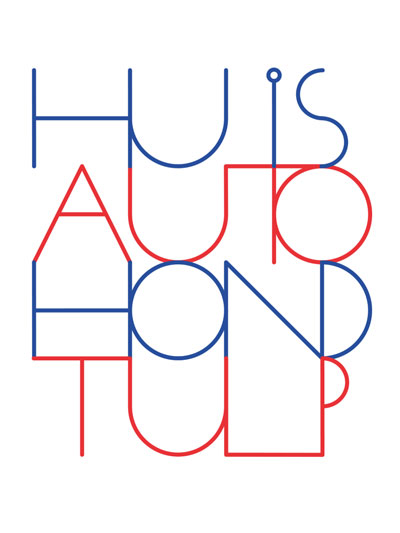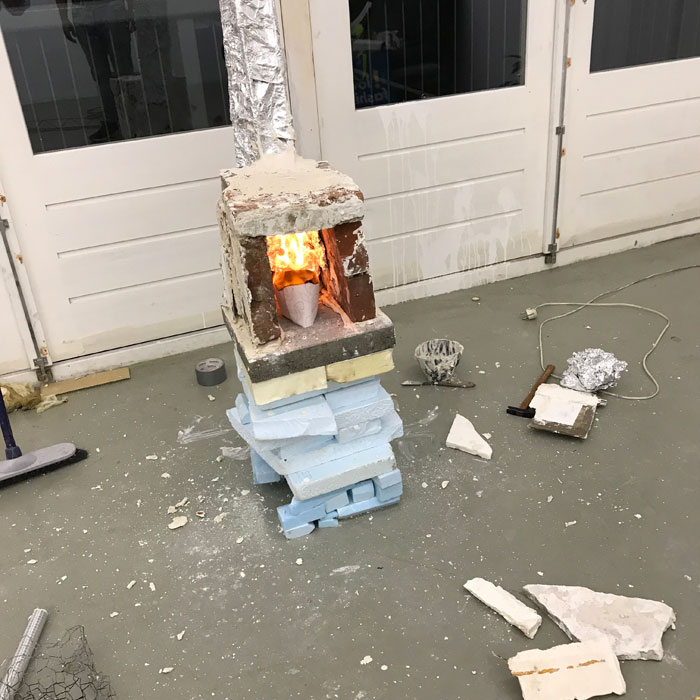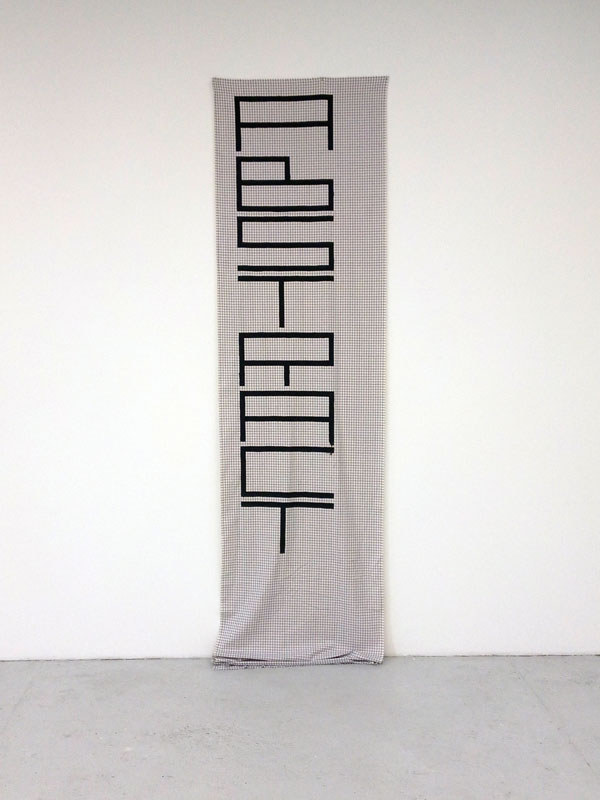current shows

|
. |
FREDERIQUE JONKER
Blue Ray One
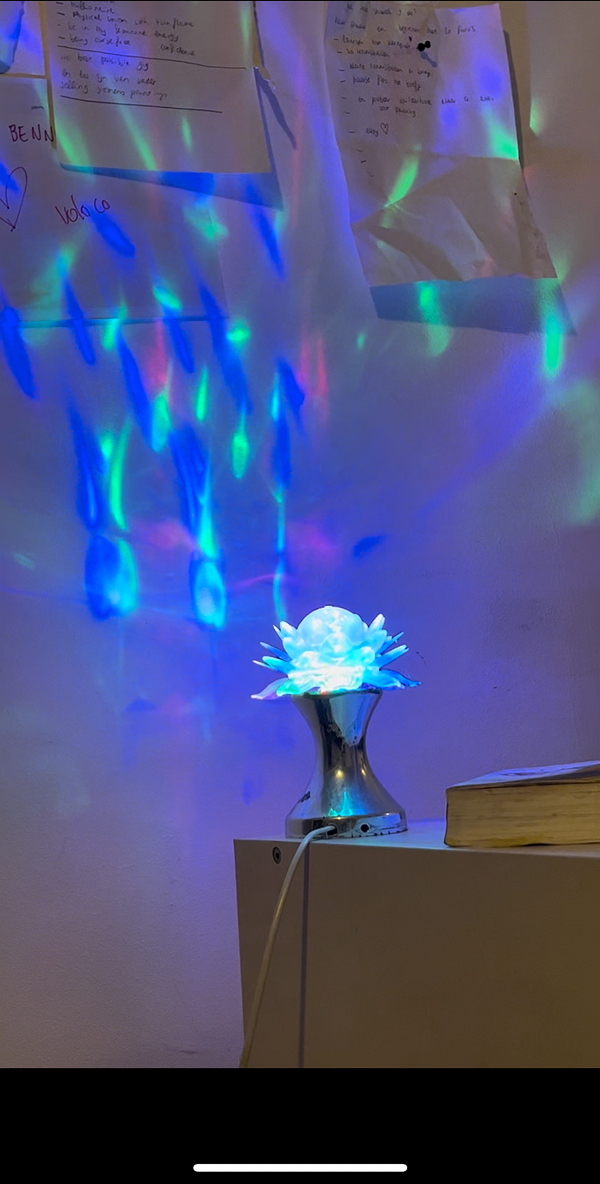
7 september - 26 oktober 2024
OPENING: 7 september, 17:00 - 20:00
'Blue Ray One' is de eerste solotentoonstelling van Frederique Jonker in Galerie van Gelder. Deze is tweeledig opgezet, bijna als een situationistische paradox. In de ene ruimte zijn de schilderijen gesitueerd in een evocatieve installatie met lichteffecten en in een andere ruimte zijn de schilderijen omringd door stilte waarin ze autonoom gepresenteerd worden in een white cube.
Bij Frederique Jonker is het luisteren naar muziek als zij aan het werk is een onmisbaar element. Het functioneert als een katalysator om beelden op te roepen; om gestuurd te worden, zelfs. In dit verband krijgt zij berichten binnen die zij ‘transmissions’ noemt. Het is in die mate essentieel dat ze in haar presentaties op de een of andere manier die positieve impuls wil voortzetten door haar schilderijen te verbinden met de energie van de rappersmuziek waar ze naar luistert. Zij doet dat in de vorm van installaties met bewegende beeldprojecties en stroboscopische felle lampen op haar doeken. Daarmee verkeren haar schilderijen in een andere situatie dan gebruikelijk is. Zij krijgen tijdelijk een ander leven of misschien wel een volgend leven. Het is een gelaagdheid die de schilderijen zèlf ook hebben. Elk schilderij bestaat uit een embryonale fase; voordat met het schilderen op doek wordt begonnen wordt elke keer een onderlaag aangebracht. Deze werkt in een volgend stadium (van schilderen) als dynamo.
Op een canvas tekent zij eerst cyborg-achtige figuren begeleid met losse woorden en flarden van zinnen die zij als een ”berichten” binnenkrijgt. Zo kan er bijvoorbeeld een zin als ‘Buy a can of yoghurt and eat it’ in haar hoofd belanden, terwijl zij helemaal niet van yoghurt houdt. Het ‘zelf’ wordt meer uitgesloten en in het verlengde hiervan zegt zij dan ook dat zij streeft naar “automatisch schilderen”.
Samenvattend lijkt haar met energie geladen werk te zijn voortgedreven door een buitengewone sensitiviteit van haar ‘aangestuurde hand’.
Frederique Jonker (1991) was in 2016-2017 deelnemer aan de Rijksakademie Amsterdam. Zij exposeerde o.a. in These Shapes Remind Me of You, Galerie Juliette Jongma (2016), Koninklijke Prijs voor Vrije Schilderkunst, Paleis op de Dam (2017) en organiseerde een grote groepstentoonstelling Everything Is On The One in Arti et Amicitiae, Amsterdam. Naast haar schilder- en tekenwerk componeert zij sinds begin 2024 computer gegenereerde muziek.
English text
'Blue Ray One' is the first solo exhibition by Frederique Jonker at Galerie van Gelder. This is twofold, almost like a situationist paradox. In one room the paintings are situated in an evocative installation with light effects and in another room the paintings are surrounded by silence and are presented autonomously in a white cube. For Frederique Jonker, listening to music while she is working is an indispensable element. It functions as a catalyst to evoke images; to be sent, even. In this context she receives messages that she calls 'transmissions'. It is essential to such a degree that in her presentations she likes in some way or the other to continue that positive push by connecting her paintings with the energy of rappers' music she listens to. She does this in the form of installations with moving image projections and stroboscopic bright lights on her canvases. This means that her paintings are in a different situation than is usual. They temporarily get a different life, or maybe a next life. It is a layering that the paintings themselves also have. Each painting consists of an embryonic phase. Before a painting on canvas begins, a base layer of drawings and words is applied. This works as a dynamo in the next stage of painting.
On a canvas, she first draws cyborg-like figures accompanied by individual words and fragments of sentences that she receives as 'transmissions'. For example, a sentence like 'Buy a can of yogurt and eat it' may end up in her head, even though she does not like yogurt at all. The 'self' becomes more excluded and in line with this she says that she strives for "automatic painting".
In summary, her energy-charged work seems to be driven by an extraordinary sensitivity of her 'controlled hand'.
Frederique Jonker (1991) was a participant at the Rijksakademie Amsterdam in 2016-2017. She exhibited, among others, in These Shapes Remind Me of You, Galerie Juliette Jongma (2016), Royal Prize for Painting, Royal Palace on Dam Square (2017) and organized a large group exhibition Everything Is On The One in Arti et Amicitiae, Amsterdam. In addition to her painting and drawing work, she has been composing computer-generated music since early 2024.
_________________________________

Peers and Pairs II - exhibition view Andy Warhol versus Kimball Gunnar Holth, 2024
Peers and Pairs II
31 mei t/m 27 juli 2024
Nicolas Chardon - Siegfried Cremer
Bert McLean - Lily van der Stokker
Frederique Jonker - Ansuya Blom
WJM Kok - John Baldessari
Kimball Gunnar Holth - Andy Warhol
_________________________________

KIMBALL GUNNAR HOLTH, Untitled, 2024
KIMBALL GUNNAR HOLTH
installation
at Art Island 2024, booth 01
17 t/m 19 mei 2024

ART ISLAND in Fort IJMUIDEN, stand 01
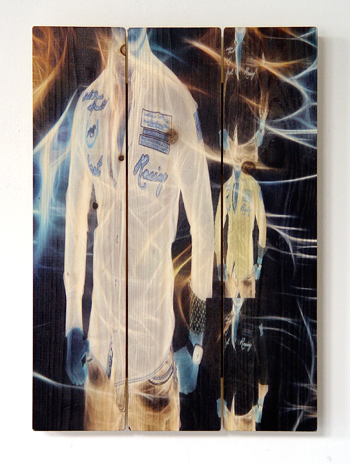
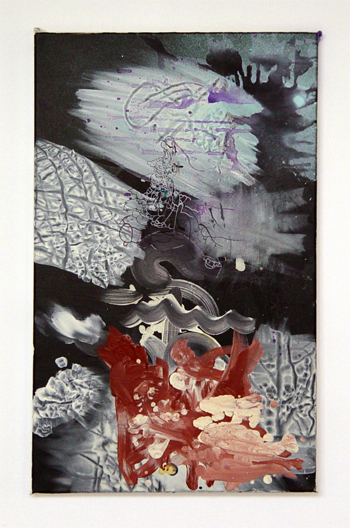
KAREEM LOTFY: Original Design, 2015
FREDERIQUE JONKER: Untitled, 2023
Peers and Pairs
13 januari - 28 februari 2024
Lee McDonald - Anna & Bernhard Blume
Klaas Kloosterboer - Nicolas Chardon
Bert McLean - David Kloosterboer
Paul Goede - Ansuya Blom
Lily van der Stokker - Paul Goede
Voebe de Gruyter - Salim Bayri
Kareem Lotfy - Frederique Jonker
Kristjàn Gudmundsson - Siegfried Cremer
Wjm Kok - Kimball Gunnar Holth
Marijke van Warmerdam - Gerhard Richter
In de tentoonstelling 'Peers and Pairs' zijn werken samengebracht van zestien kunstenaars die zijn ontstaan in een periode van 80 jaar. De werken worden in paren getoond. De makers houden zich - van jong tot oud - bezig met hedendaagse kunst zoals die komt en gaat.
Net afgestudeerde kunstenaars als Bert McLean (1998) en David Kloosterboer (2000) beleven hun eerste tentoonstelling in een galerie. Zij maken uiteraard werk dat bij deze tijd hoort, maar zij zijn daarin niet de enigen. Kristjàn Gudmundsson maakte in de jaren ’90 minimalistische grote muurwerken met behulp van potloodvullingen. Dat paste toen in die tijd, maar wordt vandaag de dag als ouderwets gezien. In ‘Peers and Pairs’ hangt een werk uit 1993 van Gudmundsson naast een glaspaneel van Siegfried Cremer uit 1964. De combinatie van hun werk maakt ondanks de generatiekloof een vanzelfsprekende indruk. Zo ontstaan beelden van generaties, die van elkaar verschillen, maar ook weer niet.
Dus wat is tijd als het over tijdgenoten gaat.
Introductie van 2 nieuwe publicaties:
- een handbeschilderd objectbrochure van Frederique Jonker, uitgegeven door GALERIE VAN GELDER EDITIONS
- een fanzine 'Apples and Pears' (2024) van Bert McLean en David Kloosterboer, uitgegeven door GALERIE VAN GELDER EDITIONS
Op vrijdag 16 februari vindt de V-séance om 16 uur plaats en op zaterdag 17 februari de F-séance om 17 uur.
English text
The exhibition 'Peers and Pairs' brings together works by sixteen artists who emerged over a period of 80 years. The works are shown in pairs. The makers - from young to old - are concerned with contemporary art as it comes and goes.
Recently graduated artists such as Bert McLean (1998) and David Kloosterboer (2000) are experiencing their first exhibition in a gallery. They obviously make work that belongs to this time, but they are not the only ones. In the 1990s, Kristjàn Gudmundsson made minimalist large wall works using pencil fillings. This was appropriate at the time, but is seen as old-fashioned today. In 'Peers and Pairs' a work (1993) by Gudmundsson hangs next to a glass panel by Siegfried Cremer from 1964. The pairing of their work looks natural despite the generation gap. In this way pictures of generations are created that are different from each other, but also not.
So, what is time when it comes to contemporaries.
At the opening on Saturday 13 January there will be an introduction to 2 publications:
- a brochure by Frederique Jonker (2024)
- a fanzine 'Apples and Pears' (2024) by Bert McLean and David Kloosterboer
Paul Goede transfers the F séance on Friday February 16 at 16 hours and on Saturday February 17th the transference of the V séance at 17 hours.
My Height in Lines
17 oktober 2023 - 6 januari 2024
Ansuya Blom
Nicolas Chardon
Sigurdur Gudmundsson
Klaas Kloosterboer
Jaap Kroneman
Wjm Kok
Jonathan Monk
JCJ Vanderheyden
&
in AP
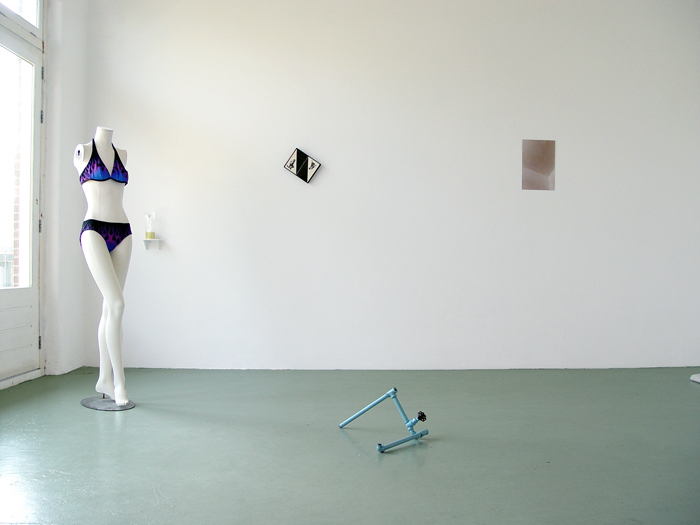
exhibition view On Hold art, Bare objects and Product art, 2023
On Hold art, Bare objects and Product art
t/m 6 januari 2024
JOHN M ARMLEDER
NICOLAS CHARDON
SYLVIE FLEURY
KIMBALL GUNNAR HOLTH
KLAAS KLOOSTERBOER
PIERO MANZONI
OLIVIER MOSSET
ROB SCHOLTE
Naar aanleiding van de karaktereigenschappen van een aantal voorwerpen in de tentoonstelling 'On Hold art, Bare objects, Product art' vermoed ik de aanwezigheid van categorieën die zich onttrekken aan zowel het 'objet trouvé' als de 'ready-made'.
English text
For the exhibition 'On Hold art, Bare objects, Product art', I searched for objects that are neither an 'objet trouvé' nor a 'ready-made'. They are objects that are distinguished by the way in which they were created and incorporated into the art world. In language use, concepts such as 'objet trouvé' and 'ready-made' are often mixed up or even used haphazardly to describe an object that is supposedly placed in a visual art context as unchanged. As something that is just up for grabs and that is then conveniently called a found object or a 'ready-made'. Based on the characteristics of a number of objects in the exhibition 'On Hold art, Bare objects, Product art', I suspect the presence of categories that elude both the 'objet trouvé' and the 'ready-made'. KvG
________________________
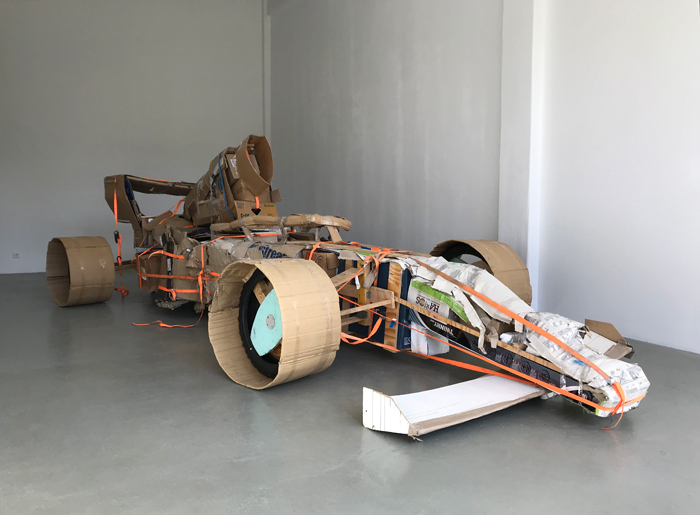
LEE MCDONALD: Formula 1, 2023
LEE MCDONALD
Formula One
2 juni - 8 juli 2023
Al het werk van Lee McDonald heeft iets voorlopigs, alsof elk beeld provisorisch tot stand is gebracht. Tegelijkertijd is het steeds met ruimtelijke precisie in elkaar gezet, hoe klein het ook is.
Elke in beweging gebrachte sculptuur voorziet hij van een testnummer. Daarbij gaat het er niet zozeer om of een test lukt of mislukt, maar veel meer om te kijken naar wat er gebeurt. Elke test wordt op videofilm vastgelegd.
Lee McDonald heeft inmiddels bijna 2700 testen uitgevoerd die variëren van zwiepende verfspuitbussen die op een muur kapotgeslagen worden tot een levensgrote Starfighter van karton, spanbanden en tape die hij vanaf een dak naar beneden laat zeilen. De kracht van zijn werk wordt benadrukt door het feit dat elke geregistreerde test op film nog steeds de energie van het moment uitstraalt waarop de test werd gedaan. De niet te voorspellen bewegingen van de sculpturen maken de filmbeelden tot een eigenzinnig en ook geheimzinnig fenomeen van oorzaak en gevolg. Lee McDonald’s machinaal aangedreven werken leiden in de meeste gevallen tot zelfdestructie.
Over zijn werk zegt Lee McDonald het volgende: “Dat een bewegend apparaat werkt is niet voldoende. Het draaien van de onderdelen komt met behulp van een mechaniek tot stand, maar in het resultaat moet altijd een onvoorspelbare beweging zitten. Anders is het gewoon een machine die zijn werk doet. Dat kan ik alleen maar ontdekken als ik het apparaat test.” Hij vergelijkt het met bewegingen die dansers maken in relatie tot de muziek die zij horen: “Ik vind het interessant om bijvoorbeeld dansende mensen te zien die niet voor de hand liggende bewegingen maken op het ritme van de muziek.”
In een van McDonald’s testen uit 2020 is hijzelf dansend te zien in zijn studio met een draaiende vliegtuigpropeller op zijn rug waarbij niet duidelijk is of hij wordt voortgedreven door het mechanisme op zijn rug of door de muziek waarop hij danst en eigenaardige bewegingen maakt.
Lee McDonald (1979, Plymouth, UK) studeerde aan het Franck Mohr Instituut in Groningen, samen met Salim Bayri, Henry Byrne, Kimball Gunnar Holth en Nokukhanya Langa. Zijn werk was op Big Art 2020 en 2021 te zien. In 2021 won McDonald The One Minutes International Competition Award in de categorie ‘Installation’. Dit jaar had hij een solopresentatie in Art Island 2023 op Fort IJmuiden.
&
in AP
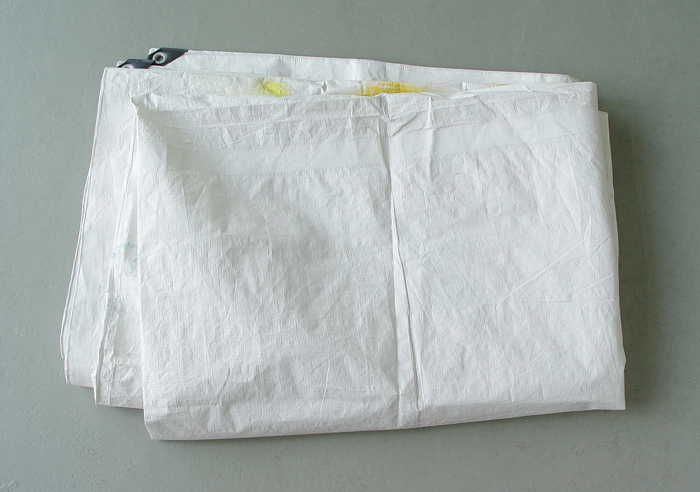
KIMBALL GUNNAR HOLTH: I was trying to think of a title and I decided to leave it alone, 2023
In between found object and already made
2 juni - 8 juli 2023
OPEN: zondag 4 juni, 12:00 - 19:00 uur
NICOLAS CHARDON
KIMBALL GUNNAR HOLTH
KLAAS KLOOSTERBOER
CHRISTIAN MARCLAY
OLIVIER MOSSET
ROB SCHOLTE
________________________
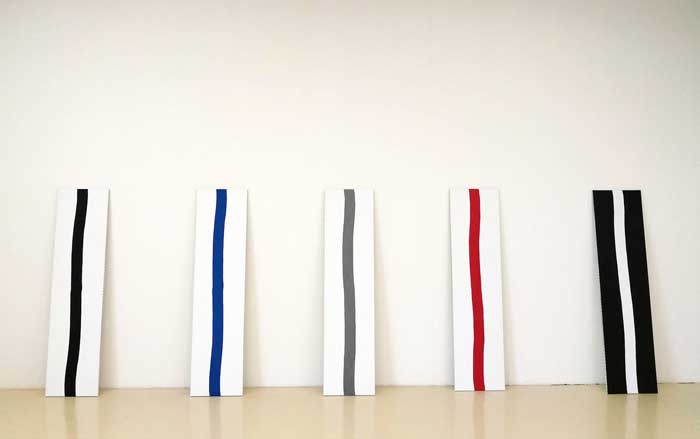
NICOLAS CHARDON: Stoppages, 2022
NICOLAS CHARDON
Stoppages
in GvG
22 oktober - 12 december 2022
for English scroll down
Het werk van Nicolas Chardon kenmerkt zich door mee te gaan met de lijnen die door een ander zijn uitgezet. Vele schilderijen zijn op industrieel bedrukte stoffen geschilderd, waarop hij tijdens het aanbrengen van een geometrisch vlak de golvende lijnen van de gebruikte ruitjesstof volgt. Ook in de hier getoonde schilderijen heeft hij dat gedaan. Het levert een speels en meegaand beeld op alsof er sprake is van een afgesproken samenwerking tussen textielfabrikant en kunstenaar.
press release
Nicolas Chardon's work is characterized by going along with the lines set out by someone else. Many paintings are painted on industrially printed fabrics, on which he follows the wavy lines of the checked fabric used while applying a geometric surface. He has also done this in the paintings shown here. It produces a playful and accommodating image as if there is an agreed collaboration between textile manufacturer and artist.
simultaneously in AP:
KIMBALL GUNNAR HOLTH
Corrections
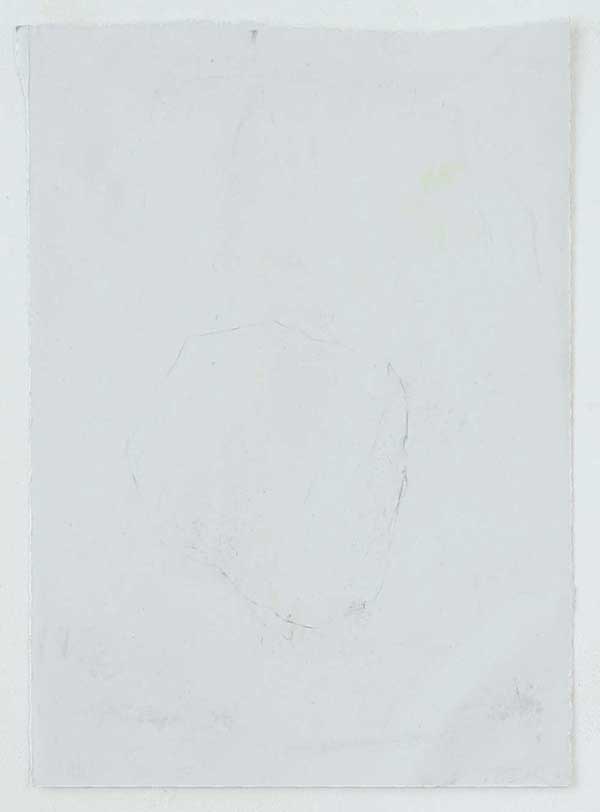
KIMBALL GUNNAR HOLTH: Erased KGH drawing, 2022
in AP
tot en met 14 december 2022
for English scroll down
De bedoeling van correcties aanbrengen is dat het leidt tot het verbeteren van wat er is, want waarom zou je anders iets corrigeren. Maar wat nu als bijvoorbeeld een gecorrigeerde tekening eruit blijft zien als een gecorrigeerde tekening? Deze twijfel van niet af of niet afgemaakt zijn is in de solotentoonstelling van Kimball Gunnar Holth het punt van aandacht. Bij hem is het een zoektocht naar een beeld voordat het een finaal werk is. Hij zegt hierover: “Ik houd van werk voordat het af is”.
In een recente serie ’Erased Kimball Gunnar Holth drawing’ gumde Kimball zijn tekeningen uit die hij als af gesigneerd heeft. Een voor hem typerend werk waarbij het onafgemaakte een tussenresultaat suggereert, maar in werkelijkheid zijn einddoel heeft bereikt. Dat maakt het anders, maar toch ook weer vergelijkbaar met een tekening van Willem de Kooning die de tekening van een ander, namelijk Robert Rauschenberg, in de jaren vijftig uitwiste.
In een andere tekening lijkt hij maar niet op gang te kunnen komen. Tot vijf maal toe tekent hij een op het droge getrokken omgekeerde houten boot waarin een gat zit. Een soort stottertekening; steeds een beetje anders gemaakt heet dit 5-delige werk ‘Drawing of a boat with a hole caused by a cow’s leg’.
Een deel van de galerievloer is opnieuw van een laag voorzien die een spiegeling suggereert te zijn van de wand en de vaalgroene vloer. Een onafgemaakte tekening die af is, een opnieuw belegde vloer die niet de hele vloer bedekt, een stuk wand deels ingerold met muurverf en deels weer gewit; het zijn allemaal werken die onderweg zijn, maar niet ergens willen eindigen. Dit is het einde zelf.
Kimball Gunnar Holth (1982, Melbourne, AU) studeerde in 2017 af aan het Frank Mohr Instituut in Groningen. In 2019-2021 nam hij deel aan enkele tentoonstellingen in Galerie van Gelder, waaronder groepstentoonstelling ‘Slaap Lekker Studio’. Momenteel is hij artist-in-residence bij 37PK in Haarlem, die zal worden afgesloten met een eindpresentatie begin november 2022. Ook keert hij in november terug naar Rome in Italië om zijn residentie bij Post Ex Roma af te sluiten met een tentoonstelling.
press release
The intent of making corrections is that it leads to improving what is there, because otherwise why would one correct something. But what if, for example, a corrected drawing continues to look like a corrected drawing? This doubt of not being finished or not being done is the focus of Kimball Gunnar Holth's solo exhibition. For him it is a search for an image before it comes to a final work.
In the series 'Erased Kimball Gunnar Holth drawing' Kimball erased his drawings which he then signed as being finished. A work typical of him in which the unfinished suggests an intermediate result but in reality, reached its final goal. He says about this: “I like work before it is finished”. That makes it different, but also comparable to a drawing by Willem de Kooning that another artist, namely Robert Rauschenberg erased in the 1950s.
In another drawing he seems unable to get going. Up to five times he draws an upturned wooden boat on dry land with a hole. A kind of stutter drawing; made each time a little differently, this 5-part work is called 'Drawing of a boat with a hole caused by a cow's leg'.
Part of the gallery floor has been re-coated, suggesting it mirrors the current wall and pale green floor. An unfinished drawing that is finished, a part of the wall partly rolled in with wall paint; they are all works that are underway, but do not want to end up somewhere. This is the end itself.
Kimball Gunnar Holth (1982, Melbourne, AU) graduated in 2017 from the Frank Mohr Institute in Groningen. In 2019-2021 he participated in several exhibitions at Galerie van Gelder, including group exhibition 'Slaap Lekker Studio'. He is currently an artist-in-residence at 37PK in Haarlem, a period that will end with a final presentation in early November 2022. Also, this November he will return to Rome in Italy to finish his residency at Post Ex Roma, also with an exhibition.
________________________
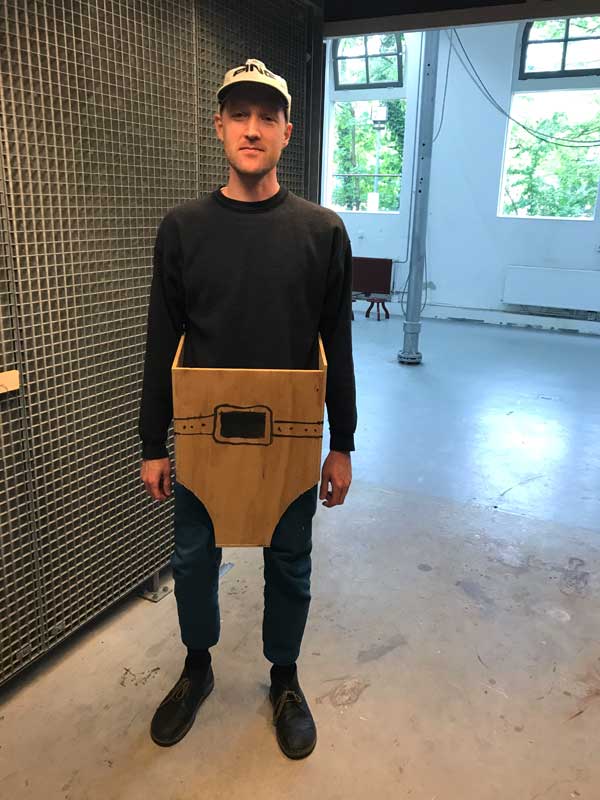
IAN PAGE: demonstrating dirty laundry wall container, 2020
IAN PAGE
we say we saw last less
and now we see may more
in GvG
2 september - 12 oktober 2022
for English scroll down
Ian Page is op zoek naar hoe de wereld van buiten er ten opzichte van de binnenkant uitziet. Op zijn eindpresentatie van de Rijksakademie in 2021 toonde hij een filmdecor met het Colosseum in Rome erop geschilderd. Achter het scherm bevond zich een lounge room met zitbank en een film die hij maakte in een trainingskamp in Californië waar Amerikaanse soldaten getraind werden om in Irak te vechten. Een in scène gezette ontploffing van een autobom, kermende gewonden en schietende soldaten maakten de filmbeelden zeer realistisch totdat iedereen als bij toverslag opstond en duidelijk was dat het ‘echte’ niet echt was.
In de tentoonstelling ‘We say we saw last less and now we see may more’ borduurt Ian Page verder op een thema dat je zou kunnen omschrijven als wat onder andere bij Nederlandse politici nu erg in gebruik is, namelijk “met de kennis van nu zouden wij toen anders gehandeld hebben”. Ian Page is ook auteur en schrijft korte essays die wonderlijke situaties beschrijven zoals in YSL (2019), een publicatie waarin o.a. een autoband wordt opgepompt met parfum in plaats van alleen maar lucht. Hij zegt over zijn teksten dat die voor hem eerder ‘extreem’ dan ‘surrealistisch’ zijn. Misschien geldt dat ook wel voor zijn beeldend werk en installaties.
Ian Page (1985, Los Angeles, VS) verbleef van 2019-2021 als deelnemer aan de Rijksakademie in Amsterdam. In 2019-2021 nam hij deel aan enkele groepstentoonstellingen in Galerie van Gelder, zoals de ‘Slaap Lekker Show’ in 2019. Deze maand heeft hij een solotentoonstelling ‘Mein Innenhof / My Patio – He Do The Police In Different Voices’ in Kunstmuseum Bochum, Duitsland. Ian Page woont en werkt in Los Angeles, Verenigde Staten.
press release
Ian Page is looking for what the outside world looks like in relation to the inside. At his final presentation at the Rijksakademie in 2021, he showed a film screen with the Colosseum in Rome painted on it. Behind the screen was a lounge room with sofa and a film he made in a California training camp where American soldiers were being trained to fight in Iraq. A staged detonation of a car bomb, groaning wounded and shooting soldiers made the footage very realistic until everyone stood up as if by magic and it was clear that the 'real' was not real. In the exhibition 'We say we saw last less and now we see may more', Ian Page elaborates on a theme that could be described as what is now very much in use among Dutch politicians, namely “with the knowledge of today we then would have acted differently”.
Ian Page is also an author and writes short essays describing miraculous situations such as in YSL (2019), a publication in which, among other things, a car tire is inflated with perfume instead of just air. He says about his lyrics that they are more 'extreme' than 'surreal' for him. Perhaps that also applies to his visual work and installations.
Ian Page (1985, Los Angeles, USA) was a resident at the Rijksakademie in Amsterdam from 2019-2021. He took part in several group exhibitions at Galerie van Gelder, such as the 'Slaap Lekker Show' in 2019. This August a solo exhibition 'Mein Innenhof / My Patio – He Do The Police In Different Voices' opens in Kunstmuseum Bochum, Germany. Ian Page lives and works in Los Angeles, United States.
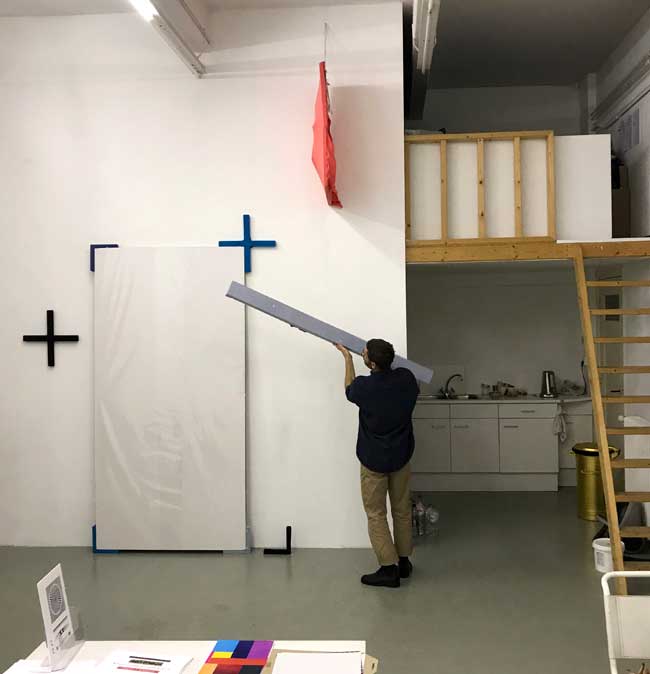
FRANÇOIS DEY: installing All and nothing, 2021
FRANÇOIS DEY
All and Nothing
in AP
homage to, and works from
Ka Moser
Raphaël Langmair
Philippe Joner
Egemen Demirci
Alper Demir
schilderijen, foto's, objecten
23 oktober - 20 november 2021
________________________
MOVE THE CURTAINS
in GvG
groepstentoonstelling
JOHN M ARMLEDER
SALIM BAIRY
SIGURDUR GUDMUNDSSON
JAAP KRONEMAN
MATTHEW LUTZ-KINOY
NOKUKHANYA LANGA
ADITYA MANDAYAM
schilderijen, teksten, objecten
23 oktober - 20 november 2021
_______________________
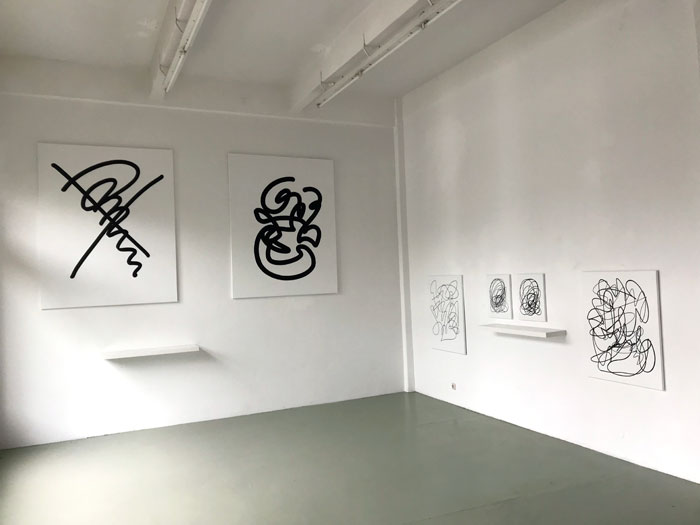
JAAP KRONEMAN: exhibition view "You're right!", 2021
JAAP KRONEMAN
You're right!
schilderijen
3 september - 13 oktober 2021
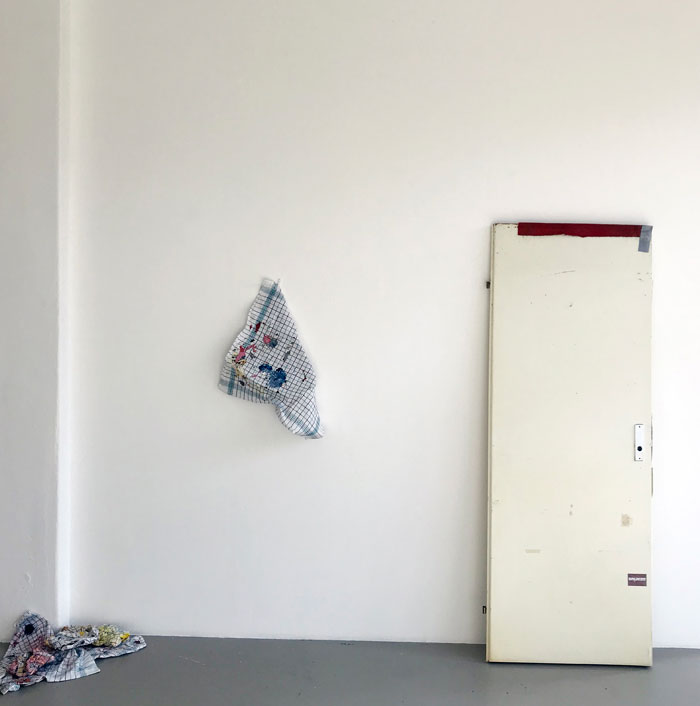
KIMBALL GUNNAR HOLTH, Door towel2021
KIMBALL GUNNAR HOLTH
17 juni t/m 14 augustus 2021
Tile painting
Kimball Gunnar Holth (1982) behaalde in 2017 een Master of Fine Arts aan het Frank Mohr Instituut in Groningen. In 2017 had hij zijn eerste solotentoonstelling bij Galerie van Gelder en in hetzelfde jaar nam hij deel aan Big Art 2017. Momenteel woont en werkt hij in Gent, België. Op Art Rotterdam 2021 toont hij in Stand 14 van Galerie van Gelder voor het eerst grote 'Broom paintings'.
Kimball Gunnar Holth starts making a work that he knows he doesn't want to finish because it is exactly there where his field of interest lies. A broom sweep across a wall, a painted canvas is crumpled, a huge bag with nothing, a stain on a tea towel; they are all a beginning that will never end into a work. Yet work is there to see.
Kimball Gunnar Holth (1982) obtained a Master of Fine Arts at the Frank Mohr Institute. In 2017 he had his first solo exhibition at Galerie van Gelder and in the same year he participated in Big Art 2017. At the moment he lives and works in Ghent, Belgium. At Art Rotterdam 2021 he will be showing large 'Broom paintings' for the first time in Stand 14 of Galerie van Gelder.
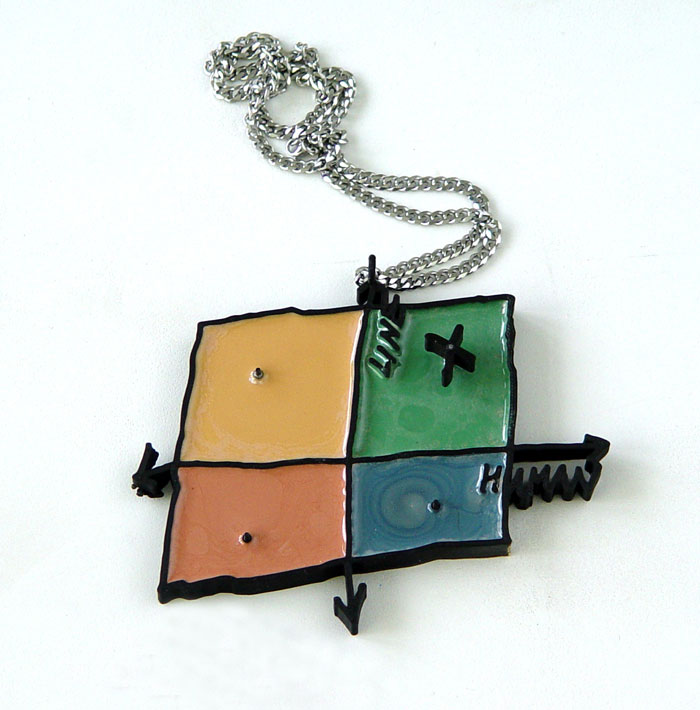
SALIM BAYRI, 'Human-Line', wearable, 2019
Art is Rattattatting!
23 april t/m 12 juni 2021
NEL AERTS
ANSUYA BLOM
ELVIRE BONDUELLE
NICOLAS CHARDON
SIEGFRIED CREMER
KIMBALL GUNNAR HOLTH
KLAAS KLOOSTERBOER
JAAP KRONEMAN
NOKUKHANYA LANGA
IAN PAGE
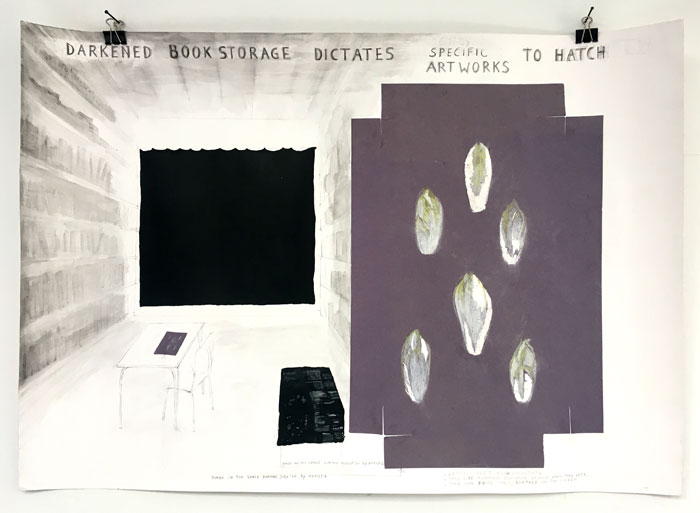
VOEBE DE GRUYTER, Darkened library dictates art works to hatch', 2020
VOEBE DE GRUYTER
Darkened library dictates art works to hatch
24 november 2020 - 17 maart 2021 - verlengd
Bij Voebe de Gruyter is er een continue interactie tussen mens en ding. Zo legde zij in haar Kauwgom-tekeningen uit 1994 (collectie Stedelijk Museum Amsterdam) vast dat geplette kauwgom op trottoirs gesproken teksten bevatten. In haar nieuwe werk worden kunstwerken door een bibliotheek uitgebroed.
In het verleden heeft zij solotentoonstellingen gehad in Marres in Maastricht, Stroom en 1649 in Den Haag. Zij exposeerde verder o.a. in België (MU.zee), Duitsland (Museum Abteiberg), Engeland (Royal College of Arts Galleries) Oostenrijk (Kunstraum Innsbruck), Verenigde Staten (Drawing Center) en China (CEAC). Recentelijk had zij in 2015 een solotentoonstelling in Club Solo in Breda. In 2014 is een grote overzichtscatalogus van haar werk en ideeën bij Roma Publications verschenen. In 2018 had zij een solotentoonstelling in Loods 12 in Wetteren, België.
The core of Voebe de Gruyter's work consists of narrative drawings based on semi-scientific concepts. She can rightly be called a narrative conceptual artist. Her exhibition "Darkened library dictates artworks to hatch" shows that driving forces influence each other and that they lead to unexpected phenomena.
Voebe de Gruyter detects a continuous interaction between people and things. For example, in her Chewing gum drawings from 1994 (collection Stedelijk Museum Amsterdam) she recorded that crushed chewing gum on sidewalks contained spoken and even sung texts. In her new work, works of art are hatched by a library.
In the past she has had solo exhibitions in Marres in Maastricht, Stroom and 1649 in The Hague. She also exhibited in MU.zee, Belgium, Museum Abteiberg, Germany, Royal College of Arts Galleries, England, Kunstraum Innsbruck) Austria, United States Drawing Center, United States and CEAC in Xiamen, P.R. of China. She recently had a solo exhibition at Club Solo in Breda in 2015. In 2014, a large overview catalogue of her work and ideas was published by Roma Publications. In 2018 she had a solo exhibition at Loods 12 in Wetteren, Belgium.
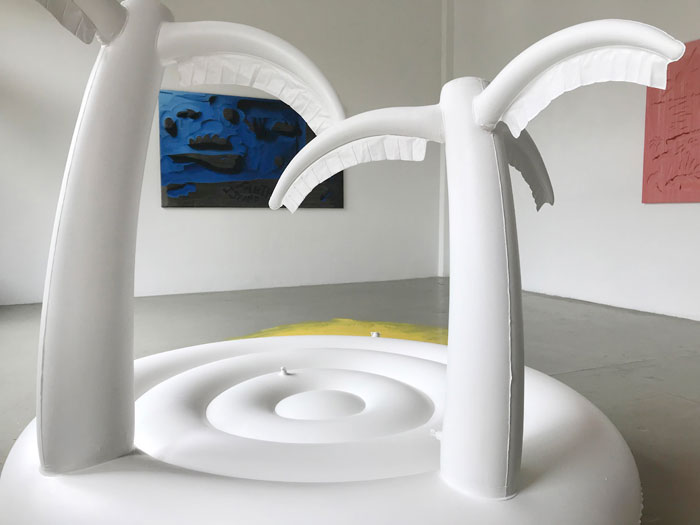
HENRY BYRNE: exhibition view, 2020
HENRY BYRNE
Tell me when to stop, OK?
3 september - 31 oktober 2020
De Iers-Engelse Henry Byrne (1985, in Londen geboren en opgegroeid) start tijdens het Amsterdams Galerieweekend 2020 zijn eerste solotentoonstelling in Nederland. Hij toont schilderijen van kunstenaars die hij zich met toestemming van de bevriende makers toegeëigend heeft. De doeken zijn van een voile-achtige verflaag voorzien en met tekst becommentarieerd. Een van de werken draagt de tekst “Tell me when to stop, OK?” en is ook de titel van de tentoonstelling.
In de achterruimte (AP) staat een beschilderde opblaaspalmbomen-op-een-eiland waaromheen zijn eigen schilderijen hangen, die zich kenmerken door een dubbele gelaagdheid. In de bovenste canvaslaag brengt hij steeds gaten aan waardoor het eronder liggende schilderij deels tevoorschijn komt. Dat doet hij soms optisch en soms letterlijk. Het is een methode van werken die hij al jarenlang in zijn werk toepast, een enkele keer met gebruikmaking van door de zon verkleurd papier.
Nou is de vraag wat het wit beschilderde opblaaspalmbomen-op-een-eiland in de tentoonstelling voorstelt. Henry Byrne zegt daarover dat het schilderij “Fantasy Island” (2020) refereert naar zijn Iers-Engelse afkomst. Als Engelsman en eilandbewoner ziet hij zichzelf als Europeaan, maar hij woont sinds een aantal jaren op het Europese continent en hij is zich meer dan ooit bewust van de geografische plek waar hij zich bevindt. Dat bewustzijn van hier en daar geeft volgens hem een vertekend beeld van waar hij vandaan komt. Hij beschrijft dat als een paradox, een botsing van een fysieke en een emotionele wereld. Henry Byrne:
“I am from an island; as an islander I have a perspective of an Irish England person. However, I am now abroad. So, I can look at my own island perspective as an insular thing and take as the 'exotic' perspective. The inflatable island is painted white so it can be repainted again, like a starting point.”
Voor deze tentoonstelling hebben de volgende kunstenaars grootmoedig een of meerdere door hen afgekeurde doeken afgestaan:
KIMBALL GUNNAR HOLTH
NOKUKHANYA LANGA
DUSTIN LARSEN
ANGUS LIAO
JACCO OLIVIER
OTTOKAJI
JOCHEM VAN WIJNGAARDEN
Henry Byrne (1985, born and raised in London) has his first solo exhibition in the Netherlands during the Amsterdam Gallery Weekend 2020. He shows paintings by artists that he has appropriated with the permission of his befriended makers. The canvases are provided with a voile-like paint layer and commented with text. One of the works bears the text "Tell me when to stop, OK?" and this is also the title of the exhibition.
In the back room (AP) is a painted inflatable palm tree on an island around which hang his own paintings, which are characterized by a double layer. He always creates holes in the top canvas layer so that the underlying painting partly appears. Sometimes he does this optically and sometimes literally. It is a method of working that he has used in his work for many years, occasionally using paper that is discoloured by the sun.
The question is what the white-painted inflatable palm-trees-on-an-island in the exhibition represents. Henry Byrne says that the painting “Fantasy Island” (2020) refers to his Irish-English origin. As an Englishman and islander, he sees himself as European, but he has lived on the European continent for a number of years and is more aware than ever of where he is located. According to him, that awareness from here and there gives a distorted picture of where he comes from. He describes this as a paradox, a collision between a physical and an emotional world.
Henry Byrne: “I am from an island; as an islander I have a perspective of an Irish England person. However, I am now abroad. So, I can look at my own island perspective as an insular thing and take as the 'exotic' perspective. The inflatable island is painted white so it can be repainted again, like a starting point.”
For this exhibition, the following artists have generously donated one or more of their rejected canvases:
KIMBALL GUNNAR HOLTH
NOKUKHANYA LANGA
DUSTIN LARSEN
ANGUS LIAO
JACCO OLIVIER
OTTOKAJI
JOCHEM VAN WIJNGAARDEN
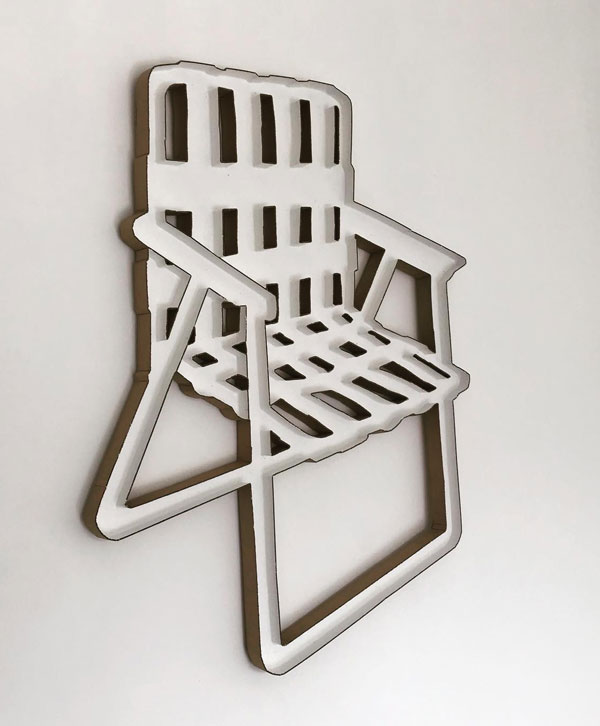
IAN PAGE, Novel model lawn chair, 2020
ÖZGÜR ATLAGAN
SALIM BAYRI
IAN PAGE
Wet rent wrong
27 juni - 4 augustus 2020
Wet rent wrong
In de tentoonstelling ‘Wet rent wrong’ is nieuw werk van Özgür Atlagan, Ian Page en Salim Bayri te zien dat zij de laatste paar maanden op de Rijksakademie in Amsterdam gemaakt hebben. Zij waren als een van de weinige kunstenaars daar nog aan het werk, terwijl vele collega-deelnemers naar hun eigen land vertrokken waren. Zij trokken dagelijks met elkaar op en bezochten regelmatig elkaars studio’s. Tijdens deze periode besloten zij om in de vorm van een losse drie-eenheid gezamenlijk een tentoonstelling in Galerie van Gelder te maken.
Op zaterdag 27 juni 2020 is de tentoonstelling open voor het publiek. De opening begint om 17:00 uur. Een maximum van dertig bezoekers is wettelijk toegestaan, maar zodra dat aantal is bereikt worden bezoekers verzocht om naar de overkant van de straat te gaan waar op een pleintje en speelplaats kunstwerken in de open lucht te zien zijn. Het zal heel mooi weer worden…., met tussendoor onweer en hagel zoals voorspeld is.
Özgür Atlagan geeft de voorkeur aan zijn aanwezigheid in de installaties die hij maakt. Voor ‘Wardrobe’ heeft hij een cabine gebouwd waarin op een monitor duizenden vervaagde roze beelden van een walk-in closet te zien zijn. Buiten de cabine bedient hij een drukknop waarmee hij de afbeeldingen laat verspringen alsof het om een dia-carrousel gaat.
Ian Page is gefascineerd door gesloten gemeenschappen die zelfvoorzienend willen zijn, zoals de Shakers en leden van de Oneida community dat waren. De eenvoud van de stoelen van de Shakers waren aanleiding voor Ian Page om die te gebruiken als uitgangspunt voor de geplette 2D-stoelen die in groepstentoonstelling ‘Wet rent wrong’ op de vloer liggen en aan de muur hangen. Afhankelijk van de manier van presenteren kunnen de kartonnen reliëfs met water gevuld zijn.
Salim Bayri beweegt zich met zijn werk tussen werkelijkheid en de weerbarstigheid daarvan. Zijn beeldgedachten zijn springerig, maar altijd doordacht. Het resultaat is een combinatie van analyse en associatie.
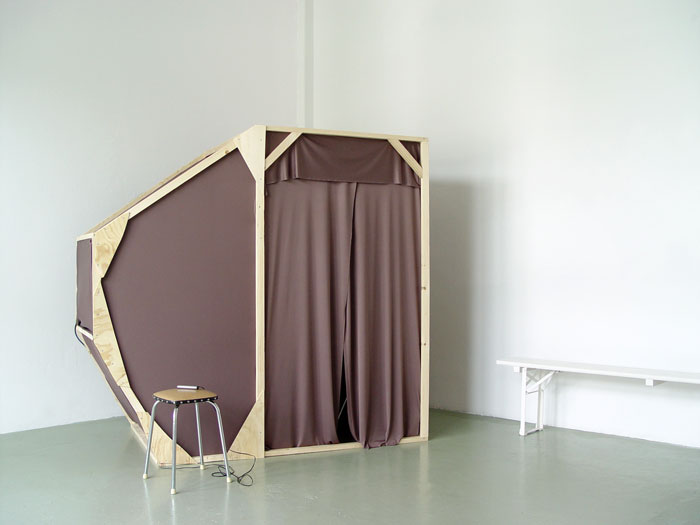
ÖZGÜR ATLAGAN: Wardrobe, 2020
English text
Wet rent wrong
The exhibition "Wet rent wrong" brings new works of Özgür Atlagan, Ian Page and Salim Bayri together who have been working at the Rijksakademie in Amsterdam the last few months in a kind of three-in-one solitude. During this period, they decided to come up with a together-show in Galerie van Gelder. Just for the sake of coming together.
Saturday 27th of June 2020 the exhibition with a tongue twister as title - as if something went wrong - is open to the public with an opening at 5 pm. A maximum of thirty people at a time are legally allowed, but as soon as this amount has been reached visitors are kindly requested to go to the opposite side of the street where in a small paved park and playground more art works are put on show in the open air. The weather will be great...., with rain, thunder and hail in between, as forecasted.
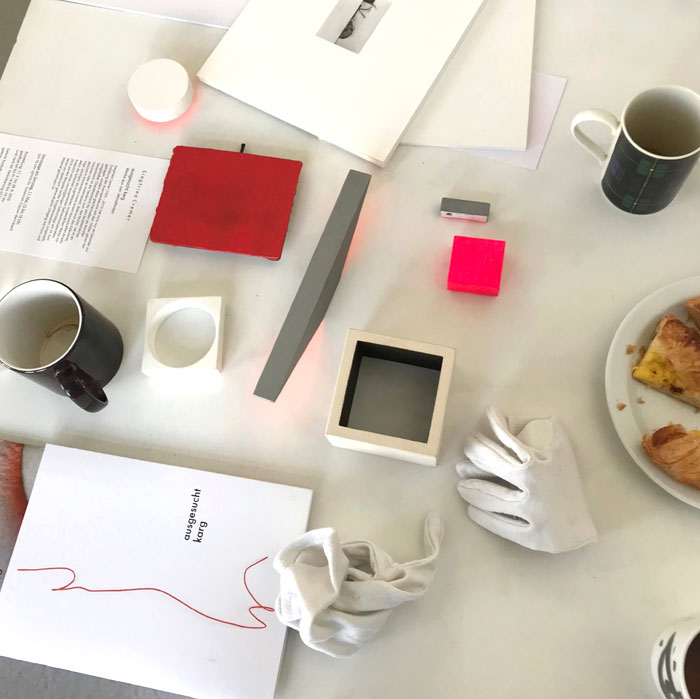
SIEGFRIED CREMER
Good morning, Mr Recyclops!
18 januari - 29 februari 2020
(verlengd t/m 14 juni)
De voorvaderen van de Neanderthalers wisten waarschijnlijk al dat het belangrijk is om te weten of een paddenstoel in het bos giftig is of niet. Het schept orde en rust. Iets dergelijks is ook aan de hand als onbekend werk in het domein van de beeldende kunst waargenomen wordt. Er lijkt alom een natuurlijke drift te zijn om te vergelijken en te categoriseren. De vraag is of dat recht doet aan het werk dat in de eerste plaats gewoon gemaakt is, weliswaar in de tweede helft van de vorige eeuw met een daarbij horende context.
‘Good morning, Mr Recyclops!’ is de tweede solotentoonstelling van Siegfried Cremer (1929-2015) in Nederland. De eerste was in Galerie M in Den Haag in 1976. In Galerie van Gelder wordt de handschoen opgenomen voor het werk zelf. Geen kunsthistorische beschrijvingen zoals die tot nu toe over zijn werk in voornamelijk Duitstalige catalogi, boeken en brochures verschenen zijn. Nee, hier staat de praktijk van het tentoonstellen voorop. Wat kan het werk in een ruimte tot stand brengen zonder dat het werk geweld wordt aangedaan? Wat gebeurt er als je kunststromingen even links laat liggen, als je het werk de kans geeft zich te verheffen door net iets meer te zijn dan dat ding als ding?
De directe omgang met het werk in het hier en nu is dan beslissend voor de mogelijke betekenissen die in het verlengde van een kijkervaring liggen en dat in een tentoonstelling zijn weerslag kan krijgen. De titel ‘Good morning, Mr Recyclops!’ is een eerste aanzet daartoe; een nieuwe dag, een nieuw begin.
Het valt niet te ontkennen dat Siegfried Cremer beïnvloed is door vriendschappen met vele kunstenaars en tijdgenoten. Het gevonden voorwerp is dan ook niet zozeer zijn uitvinding, maar wel een zeer geliefde methode voor hem geweest om tot een werk te komen dat bovenal beweeglijk en verplaatsbaar moest zijn.
Suzannah Cremer-Bermbach is kunsthistorica en zij weet wat het is om werk secuur en wetenschappelijk historisch te plaatsen. Zij is evenwel niet bang om een dergelijk kader te bevragen en tijdelijk los te laten. Vandaar dat zij in de aanloop naar de tentoonstelling ‘Good morning, Mr Recyclops!’ op de trein van Bonn naar Amsterdam is gestapt met een koffer vol werk van Siegfried Cremer. Zoals hij het zelf graag deed.
Als het gaat over ‘de kracht van het werk’ dan is de manier waarmee met het werk wordt omgegaan cruciaal. Het eigenaardige is dat een en het zelfde werk in de ene situatie een sieraad is en in een andere situatie een efemere wandsculptuur wordt. Eigenlijk begint het allemaal bij de belofte dat een werk oproept als een kartonnen doos, zoals hier uit het archief, wordt opengedaan.
English text
The ancestors of the Neanderthals already knew that it is important to know whether a mushroom in the woods is poisonous or not. It creates order and harmony. Such a thing is also at hand if one is confronted with an unknown work in the realm of visual arts. There seems to be a far and wide natural drift to compare and to categorize. Question is whether this human urge does justice to work that was purely made like that, although this was made in the past century with its own specific context.
“Good morning, Mr Recyclops!” is the first solo exhibition in The Netherlands with works of Siegfried Cremer (1929-2015) in which the challenge is taken up to show a part of his work as it comes to the viewer, in the first place. No art historic descriptions like the ones that appeared so far in mainly German catalogues, books and brochures. No! Here practice of a generous way of exhibiting stands in the forefront. What may the works establish in a space without framing the work in forehand? What happens when one leaves art movements alone for a while and the art works are given a chance to elevate themselves by being just a little bit more than that thing as thing? In that case the direct touch with the works is decisive for possible intentions of the works that may be found in the result of experiences of perception. The latter could to be shown in the exhibition. The title “Good morning, Mr Recyclops!” is a first call for this ambition, i.e. a new day, a new beginning.
There is no denial that Siegfried Cremer is influenced by friendships of many artists and contemporaries. Found objects are not really his invention, but it was definitively a favourite method of his to come to a work that above had to be vivid and portable.
Suzannah Cremer-Bermbach is co-curator and art historian and she knows what it means to describe art works accurately and in a scientific way, as such. Nevertheless she is not afraid to question art historical comparisons and also to let these alone. Hence, in preparation of the exhibition “Good morning, Mr Recyclops!” it comes to no surprise that she took the train from Bonn to Amsterdam with a suitcase packed with artefacts of Siegfried Cremer, exactly the way he very much liked to do himself.
If it comes to ‘the power of the work’ the manner of dealing with the works is crucial. It is remarkable and odd that one and the same work in one situation appears to become a jewel and in another one it becomes an ephemeral nothingness hanging on a wall. Factually it all starts with a cardboard box - like in this case from Siegfried Cremer’s archive - that is opened and then one looks in astonishment to a promise of a series of evocative objects, lying quietly in a row.
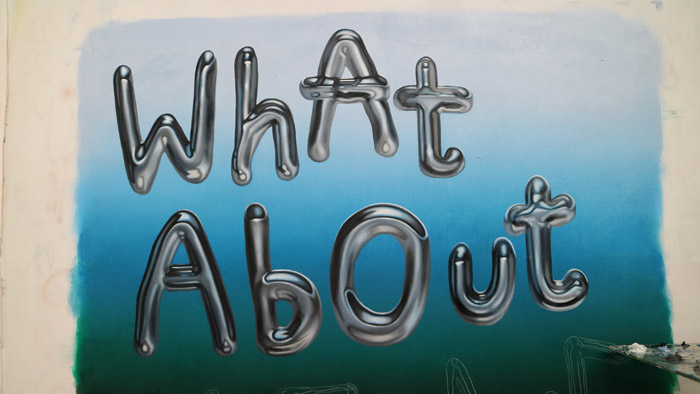
NOKUKHANYA LANGA
About what
OPENING in GvG & AP: vrijdag 22 november, 17:00 - 20:00 uur
vrijdag 22 november, 10:00 - 20:00 uur
zaterdag 23 open van 11:00 - 20:00 uur
zondag 24 van 11:00 - 18:00 uur
22 november 2019 - 11 januari 2020
In Galerie van Gelder the main wall is surrounded with a black tube-line with which a factual text statement is shown leading to a Soft Political artwork. A sculpture of fabric and painted wood and a text “Slow Fade” raises questions on borders and being pushed, perhaps. But there is one thing that is for sure when she comments on the Other: “Wherever something stands, someone will stand beside it.”
Nokukhanya Langa received her MFA Painting at the Hunter College Exchange, New York, USA in 2017. She moved to Groningen, Netherlands and started to work at the Frank Mohr Instituut where she received an MFA Painting Cum laude. In 2018 she was nominated for the Buning Brongers prize 2018. Next year her work will be presented by Galerie van Gelder at Art Rotterdam 2020.
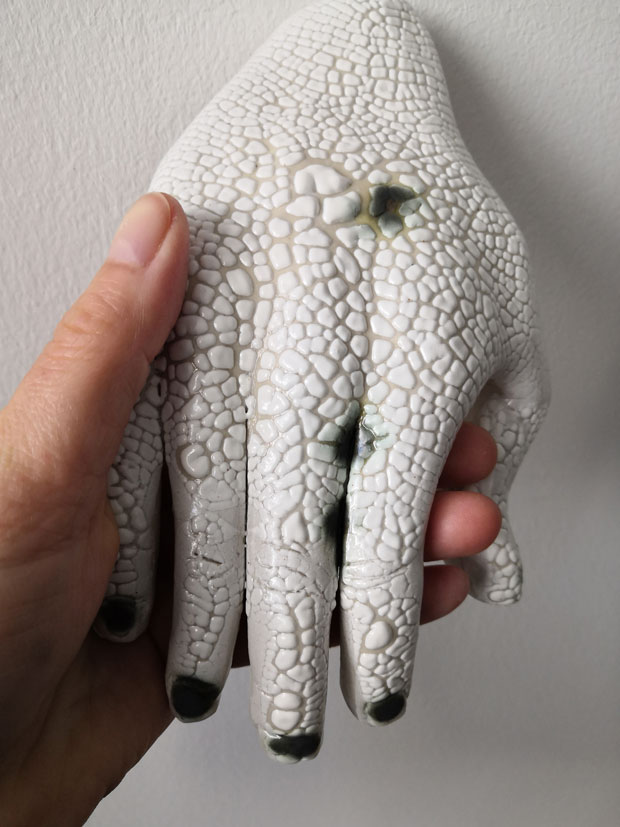
LINDA PERSSON
Between old Bones and New Moons
in AP
curator Birta Gudjónsdóttir
curator of Venice Biennale of Icelandic Pavillion 2019
OPENING in GvG & AP: vrijdag 22 november, 17:00 - 20:00 uur
22 november 2019 - 11 januari 20
Persson says about her recent works: “My recent years of artistic research have engaged with the loss of language due to colonialism and the scars felt in the landscapes we wander. Starting with a personal or historical memory, I use a sort of ‘tracing back’ as a transformative ritual to position my artistic practice as an engagement with in-depth research in the place revealed by the trace. Since 2008, I have been following these traces and acting upon the unknown encounters that develop from actually going to particular places, meeting people and engaging with folklore and oral traditions. This challenges the economics of the ‘body in motion’ as it explores borders and limits via the actual body (here, my body), which also highlights my own privilege as a white woman. As borders and infrastructures continually close down for anyone ‘other’, the importance of articulating this challenge becomes all the more pertinent.
What interests me in these places are their harsh landscapes, the histories and legends that surround them, and how they still carry superstitions that makes themselves known as an exchange or a speculative economic act. All these places are usually sites for change, be it of industry (mining), natural disaster, colonialism, or even geological deep time. And still, there is evidence of the human hand interacting over time, which gives these sites ‘humanness’ despite the extremity of the first encounter. Engaging with the oral tradition and the embodied experience of being and acting in place, provides a countermeasure that explodes and expands beyond the limitations of the accepted knowledge and value of the official collected archive. For me the ‘(re)-telling’ of a story, an anecdote related to landscape or a ‘thing’, is a magical thing in itself”.
Linda Persson was recently nominated and selected for the publication (3rd Sept 2019)100 Sculptors of Tomorrow, from Thames & Hudson edited by Kurt Beers.
Persson’s collaboration with the Wongatha women Geraldine Hogarth and the last fluent Kuwarra speaker Luxie Redmond-Hogarth, Western Australia, ‘Light & Language’ won 1stprize in Visualising Multilingualism at BAAL, Manchester Met University, England (Aug 2019).
Persson´s works have been exhibited widely, such as in the Nordic countries, Australia, England, Estonia, France, Iceland, Italy and Scotland. She completed Mejan Residence Research Fellowship in 2012 at the Royal Institute of Arts in Stockholm, Sweden. She received a MA Sculpture & Sound at Southampton University, Winchester School of Art 2006 and a BA Sculpture/ Theory at Chelsea College of Art & Design 2002.
-screenshot.png)
